

|
| Elliott Sound Products | Why Do Tweeters Blow When Amplifiers Distort? |
 Main Index Main Index
 Articles Index Articles Index
|
A vexing question, regularly asked and rarely answered properly - Why Do Tweeters Blow When Amplifiers Distort? The answers are actually quite simple, but the common misconception is that the distortion creates harmonics, and the additional harmonic content destroys the tweeter.
Not really - woofers and midrange drivers can also blow from a distorted amp, and this is rarely has anything to do with harmonics. Certainly, there are additional harmonics generated, and they will be at relatively high levels, but usually not high enough to cause more than relatively minor stress to the tweeters (in particular). It's generally safe to assume that the harmonics generated will produce more power in the tweeter, but as shown below this is only a part of the story. Also, note that simulations (as you may see elsewhere) using a single tone or perhaps a pair of tones will not show reality. Music is a complex mix of many tones/ frequencies at once, and simple analysis using one or two tones will only lead you to a false conclusion.
It is also worth looking at the article Amplifier Clipping, as this provides some additional information that is not covered below. Although it usually does not affect tweeters, the effects on low frequency drivers can be very harmful.
Because of the nature of music and the over-use of compression, it is not only tweeters that are at risk. Woofers can also be damaged, due simply to excessive continuous power. In the end, it doesn't matter if the signal to the speaker is clipped or not - if you feed excessive power into a loudspeaker on a long-term basis, it will fail. Most speakers can tolerate short-term overloads without damage, but it's dependent on the thermal mass of the voicecoil. Woofers have much greater thermal mass than tweeters, and are less likely to be damaged with momentary overloads (less than a few seconds).
Tweeters can (and do) fail in biamped or multi-amped systems with electronic crossovers - even if the tweeter amplifier never clips. If the tweeter amp has enough power and the level is increased too far, the tweeter or compression horn driver will fail, even though there are no additional harmonics present. The issue is (and always was) excessive power and the increase in level below the nominal crossover frequency. How this comes about varies widely, but you can't simply blame additional harmonics and pretend you've explained the problem !
Note that this article has been substantially changed (twice now). The conclusions are the same as the original, but new graphics have been added to show the waveform and an FFT of the tweeter signal under three different drive conditions. Hopefully the new information will make the article clearer, and the new simulations show the fundamental and harmonics so you can see the relative effects of clipping induced compression and harmonic generation. While the latter is certainly a contributor to the total power, its influence is far less than you may have expected.
It should be immediately apparent to most people that a (say) 10W speaker cannot be damaged by a 1W amplifier ... provided it sends no low frequency energy to a tweeter. Even then, it's pretty unlikely that even a tweeter would be damaged by a clipping 1W amplifier. Clipping is just a different waveform, (tending towards a squarewave when taken to the extreme). There are no waveforms that cause speaker damage, and a few speaker manufacturers test their systems to show that they can reproduce a squarewave! Needless to say, that does not cause damage, because the power is deliberately limited to a safe level.
A great part of the mystery is uncovered when we look at two aspects of music - the average versus peak power, and the energy distribution of typical music material.
It is commonly accepted (and quite valid) that music has a peak to average ratio of about 10-20dB. This means that if the signal is being amplified by a typical 100W amplifier, the amp's power rating limits the absolute maximum power to 100W (give or take a little). Since this is the peak, the average must be somewhat lower, and we will assume 10dB for the sake of convenience. Average power is therefore 10W or less at the onset of clipping. This is something that I've verified as being fairly accurate, particularly with 'contemporary/ modern' music. Orchestral works will (or should) have a greater dynamic range, but assuming 10dB is 'safe'.
This is not dynamic range per se, but it is most certainly a part of the overall dynamic range of the music signal. The term 'dynamic range' usually refers to the very quietest up to the very loudest passages in a given piece of music. In some cases, there is no variation whatsoever - it starts loud, is loud in the middle, and (just to be different) finishes ... loud. The peak to average ratio may also be compressed, but it is difficult to reduce it to much less than 10dB without it becoming flat and lifeless. If done incorrectly, it can simply become a jumbled mess with no intelligibility whatsoever (and no, I'm not going to take this to its logical conclusion and denounce various styles that may be classified as music by only a select few  ).
).
Most speakers are rated for a continuous power and an instantaneous power - the voice coil and to a lesser degree the suspension can withstand short bursts at much higher powers without damage. This does not imply that such power will be reproduced cleanly, and it will almost certainly be with a large increase in speaker distortion. The peak power rating defines the maximum transient power the loudspeaker can handle without suffering electrical or mechanical (stress induced) damage.
Nearly all tweeters are rated to 'system power', and this will usually be quoted relative to a specific crossover frequency. A hypothetical tweeter may be rated at 100W system power when crossed over at 3,000Hz. The power that it can withstand is not 100W! Not at any frequency or for any duration. The actual bandwidth-limited long-term average power for most tweeters is around 10W, but many can't even handle that much without some distress.
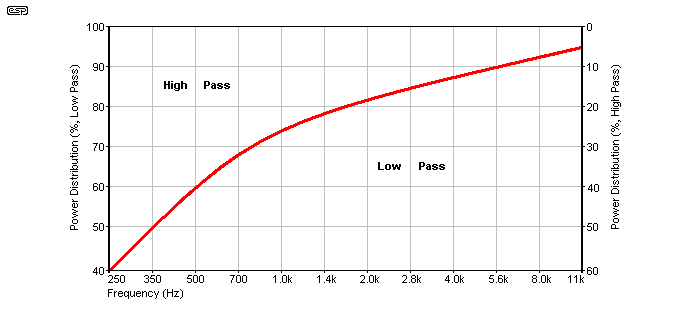
The above power distribution table is approximate (as must be the case), and applies for 'typical' music - whatever that may be. If we look at the case for a crossover frequency of 3kHz, we can see that 85% of the power is in the low frequency spectrum, and only 15% in the high frequencies above 3kHz. It is not difficult to deduce from this that the peak power to the tweeter will be in the order of 15W at full power from the amplifier, with the average hovering around 1.5 watts.
This is the way the system was designed to be used, and as long as the power amp does not clip, all is well (well, almost - read on).
When an amplifier is overdriven, the sound becomes distorted. This manifests itself in many ways, but the two we are interested in are the generation of harmonics, and the reduction of dynamic range - both the true dynamic range and the peak to average ratio. Let's assume that the amp is overdriven by a mere 3dB, so the average level is now 20W, and the peaks are clipping. With many systems (or listeners), this will be virtually inaudible. Careful listening will uncover the fact that there is distortion present, and there is a definite reduction of intelligibility.
The speakers - both tweeters and woofers, are now being asked to absorb twice the power that would be normally obtainable, and the power is more constant - the signal is compressed by the power amp. Add to this the additional harmonics generated by the clipping waveform, and the tweeter may actually be getting up to 3 times the continuous power that was available before clipping. Peak power remains the same, since it is limited by the amplifier's power supply voltage.
Now, let's overdrive the amp by 10dB. The amp is delivering in excess of 100W, since it is reproducing square waves much of the time. The woofer will be subjected to perhaps a continuous 100W of power, and around 15W continuous will be available to the poor tweeter. Of this, probably less than 1% will be converted into sound (1% represents an efficiency of about 92dB/W/m). Ferrofluid helps, but virtually no hi-fi tweeter can withstand that sort of continuous power for any duration.
The tweeter was never designed for that! Just look at a 10W wirewound resistor for example. It is big and chunky, and made from a ceramic material that is designed to handle a lot of heat. Run one at 10W to find out just how much heat you will get. There is very little airflow around the tweeter voice coil, and the heat has nowhere to go. The result is that the voice coil will quickly overheat, and the adhesive that bonds the coil to its former, the former itself, and even the enamel insulation on the coil will be damaged. The result (naturally) is a dead tweeter.
As for the woofer - unless it is designed to take 100W or more continuous sinewave power, it will also overheat and eventually die. It takes longer because there is airflow around the voice coil, and the coil is bigger and has greater thermal inertia, but die it must if the abuse is maintained.
The following diagrams illustrate the above. The waveforms below are the result of simulation, but 'real life' will show exactly the same things as described. The waveform used for the simulation was made up from the following signals ...
| Frequency, Hz | Peak Amplitude (V) | Relative Amplitude (dB) |
| 160 | 10 | 0 |
| 400 | 10 | 0 |
| 1 k | 8 | -2.0 |
| 2 k | 7 | -3.1 |
| 3.5 k | 6 | -4.4 |
| 5 k | 5 | -6.0 |
| 9 k | 3 | -10.5 |
| 13 k | 2 | -14.0 |
This waveform is not an attempt to reproduce any musical instrument or section of music - it is simply a batch of frequencies that make up a suitably interesting (but representative) waveform. Of great importance is the ability to use this signal to demonstrate how the relative levels at various frequencies are affected by clipping. The peak to average ratio of the signal used is around 8.56dB. As noted above, this is (typically) about what we can expect with music, and because no frequency is below 160Hz it is realistic for a mid+high system used with a separate subwoofer. Unfortunately, it is simply not possible to cover all possibilities, but I believe that the test waveform used is sufficiently realistic to provide a useful result.
If the two low frequencies are summed, the output is 9.8V RMS and with all frequencies it's 11.2V RMS - an output power of 15.7W into an 8Ω load. That's the base level, just below the onset of clipping (±30V). The single frequency sinewave level is 21V RMS, or 56W into 8Ω. This is a perfectly reasonable starting point, and describes a great many systems in common use.
The signal (both normal and clipped) was passed through a passive 12dB/octave Linkwitz-Riley crossover network set at 3kHz. This was done so it's typical of the results seen with a conventional passive speaker network. Lower order passive filters and/or lower crossover frequencies will make the situation worse.
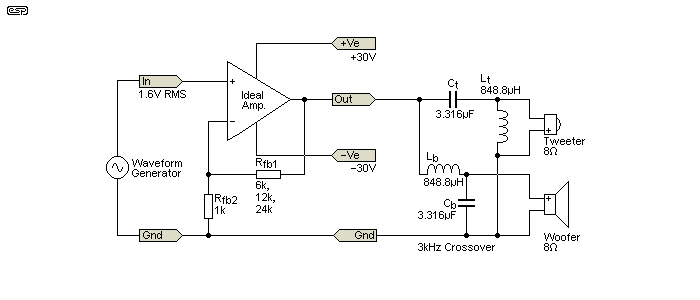
The simulated amplifier and crossover used for the following charts and graphs is shown above. It has a supply voltage of ±30V, with a nominal rating of 56W into 8 ohms. This was selected for convenience as much as anything else, but the results are no different with real amplifiers - regardless of power. Once the amp clips, more power is available to both the woofer and tweeter, and surprisingly little of the extra is the result of harmonics (often claimed to be the reason that tweeters fail). The crossovers are set for optimum accuracy, and the speaker loads are assumed to be purely resistive.
The first set of graphs was with the amp's gain set so that the system was right to the maximum voltage swing, but with no clipping. Total amp output was measured at 11.2V RMS, and the peak to average (RMS) voltage ratio is 8.56dB. The gain was then increased by ~6dB (actually 5.38dB) for the 'slight clipping' example, and a further ~6dB (5.68dB, or 11dB total) for 'moderate clipping'. The 'odd' gain increments are due to a simplified feedback network (Rfb1 and Rfb2).
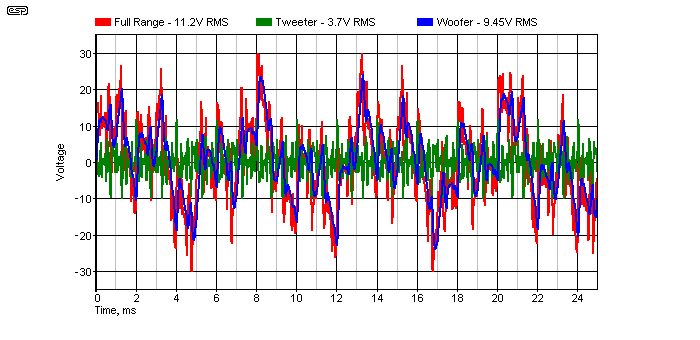
This shows the waveform at a level just below clipping. The red trace is the full range signal, green is the signal to the tweeter, and blue is the woofer signal. Notice that the tweeter signal is continuous - there are no breaks or discontinuities. This is important as we shall see from the next waveforms.
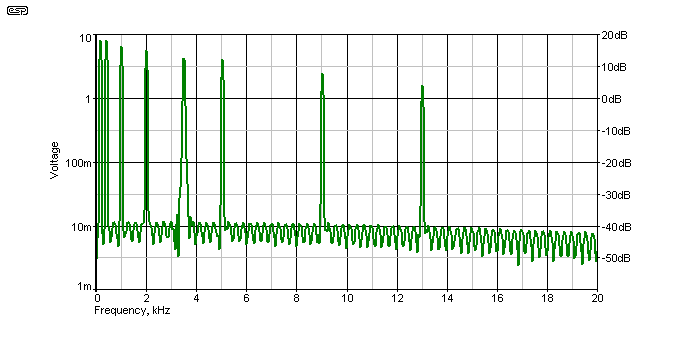
The above shows the spectrum of the composite waveform, with the amplifier voltage set at just below the onset of clipping. This is the reference, and the spectrum simply shows each frequency at its preset level. The RMS voltage of the tweeter signal is 3.7V, compared to 11.2V (RMS) for the total signal before the crossover.
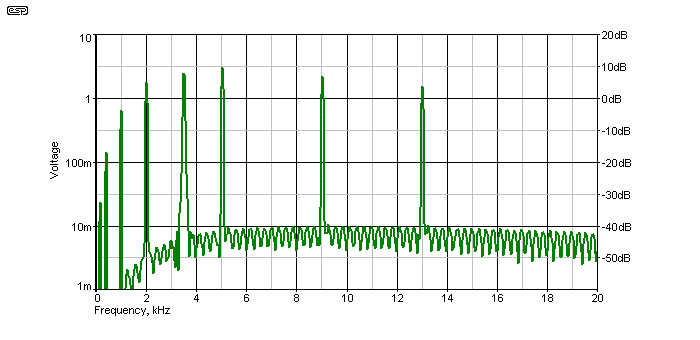
Figure 2.4 shows the spectrum of the signal presented to the tweeter. As you can see, it reflects the respective levels, with the low frequencies suitably attenuated by the crossover network. In particular, take note of the 'base' level (this is partly an artifact of the FTP process). The important part is that it's at a level of 10mV, or -40dB referred to 1V (equivalent to 12µW, so it can be ignored).
The clipping is visible, and the peak amplitude has increased. The overall spectrum shows that the background energy level (i.e. any frequency that was not part of the input) has risen from around 10mV to an average of about 100mV below 20kHz. This is relatively insignificant, but also note that the peak levels of the input signals are also greater than the previous case.
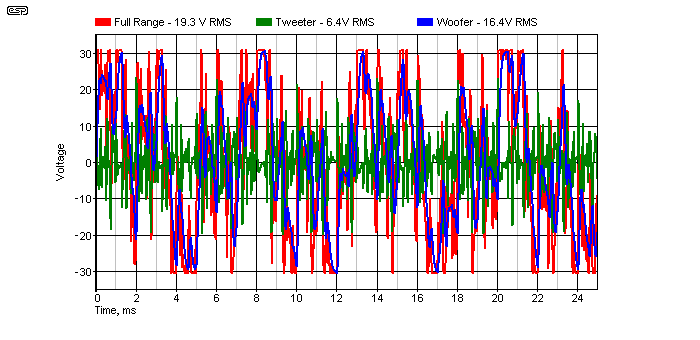
Of particular concern are those frequencies below the crossover point (3kHz) - 400Hz, 1kHz and 2kHz peaks are noticeably higher than in the previous graph - a clear sign of impending danger. Overall level to the tweeter has increased from 3.7V to 6.4V. There are portions of the waveform where the tweeter amplitude is reduced, simply because the high-frequency content is removed when the low frequency content clips.
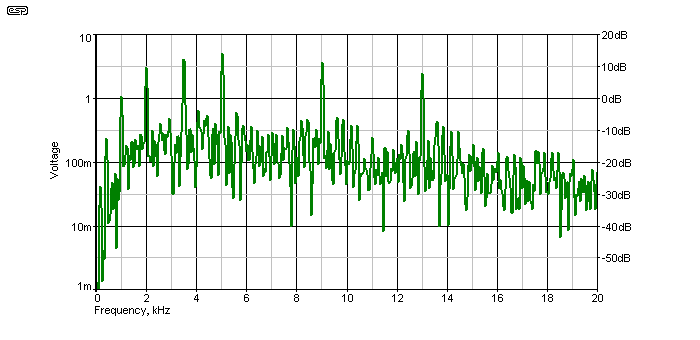
The spectrum overall shows that the average level of the signal and harmonics has increased as described above. At this level, there is some degradation of sound quality, but it could easily be missed during casual listening. Most systems (and tweeters) will survive this for a while, but there may be some degradation of the adhesives and enamelled wire used to construct the voicecoil.
The tweeter voltage is now 6.4V RMS, and the total signal measures 19.3V. This means that the total signal voltage has increased by 4.7dB, and the tweeter signal level has increased by 4.76dB. The base level has increased from -40dB to -10dB (referred to 1V), an equivalent power level of .
Increasing the gain further (another 6dB), the waveform is now visibly distorted, and if you look at the green trace (the tweeter) you can see that there are very noticeable 'dropouts'. When the overall signal clips, sections of high frequency signal are simply lost, and are (to a limited extent) replaced by harmonics of the clipped waveform. These harmonics do not replace (musically speaking) the frequencies that were removed by clipping.
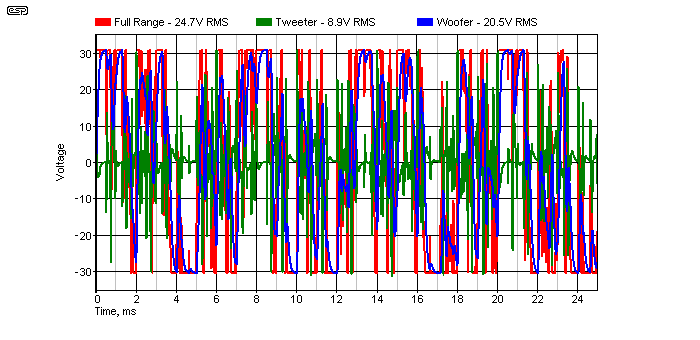
The relative amplitudes of the tweeter signal and the full range signal show us that while the tweeter voltage has increased to 8.9V, the overall is now 24.7V. This is an increase of 7.6dB for the tweeter, and 6.9dB for the overall signal (compared to the unclipped waveform). There are now significant sections of the tweeter waveform that are missing - look carefully at the green trace, which falls to near zero when there is a period where the main waveforms are against either supply rail (red - full range and blue - woofer). Despite these periods of no power, the average tweeter power is increased to a potentially damaging level.
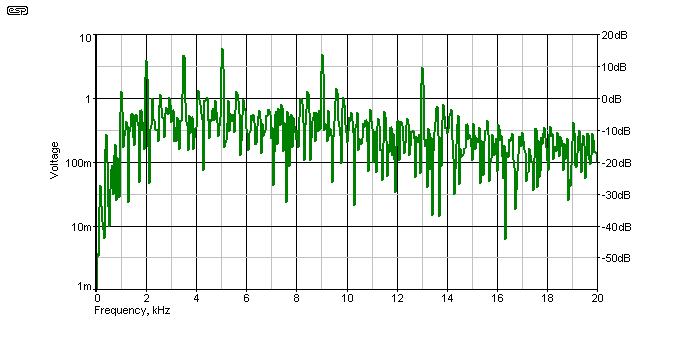
The overall level is now much greater than before - it has risen quite dramatically over the entire spectrum. Not only are the wanted frequencies at a higher level, but so are the harmonics of the lower (clipped) frequencies. However, the background 'noise' of the harmonics is still more than 10dB below the peaks, so the contribution from harmonics is not great. The harmonics are mainly confined to the 'base level', which has increased from -10dB (slight clipping) to around the 0dB level. Remember that a 10dB increase is a ×10 increase in power.
What we see is the increase of signal level to the tweeter, with the moderate clipping example showing a 7.6dB increase. Remember that this translates to an average power increase of over 5 times to the tweeter. If the tweeter would normally be expected to handle a peak power of 15W and an average power of perhaps 5W (based on Figure 1 and a 100W amplifier), a 7dB increase will take that average to 25W! The tweeter will not survive.
The above examples represent a total gain increase of 12dB from the non-clipping condition to the moderate clipping states. As the gain is increased further, the 'power compression' effect described becomes worse. At no time does the additional energy of the harmonics created by clipping exceed a level of more than around -7dB with respect to the fundamental frequencies - unless one goes absolutely berserk and forces the amplifier into total square-wave clipping. That will occur with 20dB of excess gain (i.e. 20dB above the clipping level, based on the waveform described above).
With the volume advanced by 12dB above clipping, the average power is well above danger level. The distortion will be highly audible with most music, but is not at all uncommon. Parties are probably the worst offenders, although I have heard many high power (10kW or more) PA systems driven to at least this level of distortion.
Bear in mind that most 'ordinary' (non-audiophile) people will not be aware that there is anything wrong at this point! During 'festivities' (for want of a better term), liberal quantities of alcohol enriched fluids (and/or other 'substances') will ensure that ears remain unresponsive to the assault. Given the number of times I have heard about peoples' speakers 'blowing up' during (or after - allegedly) a party, we can safely conclude that the requirement for more noise is far greater than any need for fidelity.
Few tweeters will last long with sustained power at a level easily achieved with an overdriven 100W amplifier - they are simply not designed for it. Midrange speakers and woofers will probably be pushed beyond their limits as well. Remember too, that not only is the 'in band' signal increased, but so is the out of band signal. The tweeter must also handle many times the normal power at all frequencies below the crossover frequency. This alone can cause damage, without the heating effects of such a high sustained power level.
Is the last example extreme? Not at all - I have actually understated the reality. When any system is driven so hard that the distortion is obvious to even untrained ears, it is reproducing close to square waves much of the time. A 100W amplifier driven to full power with a square wave will produce 200W, and when driven into heavy clipping with a music signal can easily achieve well over 100W average continuous power.
Conclusion? ... Exit tweeters (and/or midrange drivers and/or woofers).
The term 'power compression' is used here to describe the way that the power level is increased as an amplifier clips. Although it is covered above, the original drawings I used showed the effect, although I was never very happy with the drawings themselves. The new images are a capture from an FM radio that I have connected to my PC, and hopefully show the effects better than before.
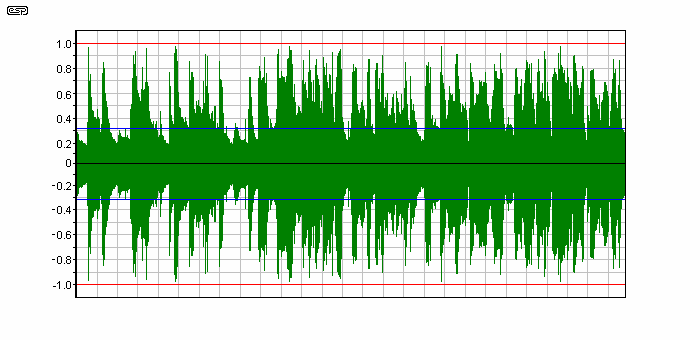
Figure 5 shows the captured signal, and the red line indicates the clipping level. The signal shown was captured over about 20 seconds, and as you can see, the signal never reaches the red line. The average can be determined roughly by eye, and it's just above 0.3 on the scale (blue line). Since the chart shows voltage, that's roughly one tenth power, or 10W for a 100W amp. Assuming a peak-average ratio of around 10dB is generally fairly close, so a 100W amp will deliver around 10W average power with 'typical' music (assuming such a thing exists  ).
).
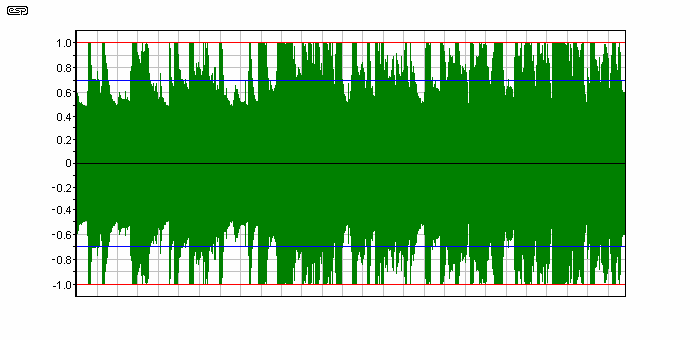
Advancing the volume control by only 6dB (double the voltage gain) pushes nearly all peaks beyond the red line (representing the amp's maximum power), so the signal clips heavily. The average power is now around 0.7 on the scale - this is the half power point (3dB below maximum power), so the average is now 50W for the same 100W amplifier. This means that the power delivered to the woofer is ×5, and power to the tweeter is a little more than that because of the additional harmonics.
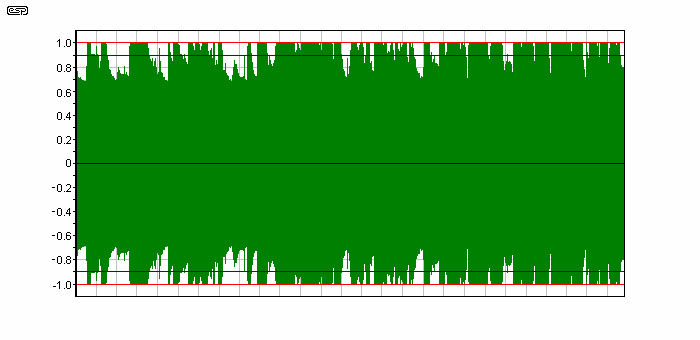
A further 6dB gain increase is very bad news indeed. The average voltage is at least 0.9 on the scale, and that means that the average power is a minimum of 80W. Because the signal is clipped so badly, there will be times when the output power will be well over 100W. To understand this, remember that a squarewave has double the power of a sinewave, so a 100W (sinewave) amplifier can deliver 200W with a full-power squarewave signal.
With this much clipping, the tweeter will be subjected to far more continuous power than it was ever designed for. As in the previous example, it will not survive.
These last three diagrams are another way of showing exactly the same thing as described with the example power waveforms, but over a longer period of time. The result is the same in either case (since they describe the same thing). All loudspeaker drivers in your system are at risk, and the tweeter (being the most fragile) is usually the first to go.
As for claims that a bigger amplifier won't clip, so won't blow your speakers - be very careful! Remember that I have covered clipping at 10dB (or a little more) above the amplifier power, and although highly undesirable, it does happen. 10dB above 100W is 1kW! Will your speakers survive being driven with peak power of 1kW? The answer (of course) is "no!"
All the above is valid when an amp clips, but what about speaker drivers that blow for no apparent reason, and with no clipping at all? Well, the people who create the final mix for CD (and those who actually transfer the final mastered tracks to CD format) have been using compressors for a long time - almost as long as music has been transferred to mass media in fact. What is different now, is that many of them seem to use their compressors with increasing vigour. The result is music that is compressed so heavily that the 10dB peak to average ratio we used in earlier examples no longer applies. Each individual recorded track is compressed, the final mix is compressed, and it may be compressed yet again before it is transferred to CD. For reasons that I cannot fathom, it seems that every new CD that is released has to be 'hotter' (louder) than the last. Guess what people - there is a limit, and we reached it long ago !
Towards this end (and to make matters worse), you will find some CDs that are pre-clipped, with the peaks of the occasional loud signal neatly cut off at the top and bottom. With a peak to average ratio of perhaps 6dB in the worst cases, we need to examine the effects on the loudspeaker drivers.
Using the same 100W amp as above, it was already established that the average power would be around 10W at the onset of clipping. Although this is not a trivial amount of heat, most speakers will be able to dissipate it without too much difficulty. As the peak to average ratio is reduced by compression, the effect is exactly the same as clipping the amp, except we don't get the harsh distortion.
With a 6dB peak to average ratio, the poor loudspeaker now has to cope with an average power of 50W as the peaks reach clipping level. Unless you are dealing with serious professional drivers that are designed for continuous high power, 50W is a lot of heat to dispose of. Should you be using a 200W amp, that increases to 100W - continuous! If you think 100W is trivial, try holding a 100W resistor that is dissipating its rated power. Actually, don't! You will burn yourself quite badly. Remember that over 99% of all power that goes into a domestic loudspeaker is dissipated as heat, with less than 1% being converted into sound.
As you can imagine, it is entirely possible to destroy drivers without ever letting the amp clip. Speaker systems rated for 200-500W almost always refer to peak power, and the average (or continuous) power rating is in reality as little as 10% of that claimed. This is perfectly alright for most people in a domestic environment, where very high SPL isn't needed. If you like to listen really loud, then you will almost certainly have problems with drivers failing. Perhaps the loudspeaker manufacturers haven't quite got the message that a great deal of music is compressed much harder than they anticipated.
The above applies to tweeters, midrange drivers and woofers equally - all can be damaged by excessive sustained power. Regardless of claims, there are actually few loudspeakers that can withstand 100W of continuous average power for any length of time. To be able to do so requires large diameter voicecoils (preferably with aluminium formers to aid heat removal), vented pole-pieces, finned magnet assemblies and somewhere for the heat to go - preferably not just into the cabinet where it can't escape. This is not a trivial exercise, and professional drivers that can withstand that sort of abuse are very expensive indeed.
Finally, the CD (and other digital formats) allow the recording engineer/ producer to have as much bass as they want, plus some more for good measure. This can extend to very low frequencies - below audibility in fact. Tuned (vented) loudspeaker enclosures (usually) provide better bass extension than sealed types, but if there is any material recorded (and amplified) that is below the box tuning frequency, this will cause massive woofer cone excursion because the rear of the cone is unloaded below the vent tuning frequency. You won't hear the deep bass, but the cones will move very energetically indeed, and can easily reach physical excursion limits. Loudspeaker damage is guaranteed if this is done at high power levels, and can include buckled and/or detached voicecoils, broken lead-in wires and torn suspensions.
A persistent myth in the audio industry is that clipping damages tweeters, so you should use a bigger amp to ensure more headroom so the amp won't clip. This claim is bollocks! Take the 100W amp described above, and replace with an amp big enough to prevent clipping ... even with the additional 12dB input signal as shown in Figure 7. Since a 100W amp was just below clipping with an average output of 16W, if we add 12dB that takes the peak amp power to 1.6kW (near enough) and the average power will be 254W.
Do you imagine for an instant that this amp won't blow the tweeters (and everything else) if the output level is increased by 12dB (until it's just below clipping)? Everything will fail, and usually fairly quickly if the speaker was designed for a 'nominal' 100W input. It is simply nonsense to imagine that the loudspeaker drivers in a 100W speaker can survive an average power of over 250W and peak power of up to 1.6kW.
If a user often turns their amp up to beyond clipping levels, they will probably do the same with a bigger amp. They might even turn it up more, because it won't have the distortion component which increases apparent loudness until the average power is a great deal higher. Such users will never hear signs of speaker distress if they can't even hear gross clipping. Speaker failure is a certainty, even if their 1.6kW amp only ever clips a few transients. They can expect the tweeter to fail, and the woofer to catch on fire.
So, while it's perfectly alright to allow perhaps 3-6dB or so of headroom for the power amps, that relies on that fact that it is reserved as headroom! If you use the extra power then there's no headroom any more, and all the effects explained will still happen, but at even higher power levels than described above. Also, consider that our ears compress too, as this is the only way we can withstand very high levels (120dB or more). When our hearing is in 'compression', distortion is much harder to hear than at more sensible levels. When I was involved in live music, I'd put my fingers in my ears to reduce the level so I could hear distortion that was otherwise inaudible. Most sound reinforcement systems back then were distorted, some more than others.
Unless you listen at comparatively low SPL most of the time, consider adding a clipping detector or a peak-reading meter to display the peak voltage. There's no point 'calibrating' a meter for power because a loudspeaker is not generally a constant resistance. Speakers have impedance, and it can vary over a surprisingly wide range (4Ω to 40Ω for example). However, if you have a 100W amplifier (8Ω) you know that the nominal voltage for full power is 28V RMS (40V peak). Should you find that this is approached (or reached) on a regular basis then you know that the amp is probably clipping transients. Should the clipping indicator or meter show maximum level most of the time, then your speakers probably won't last very long.
Consider two examples based on the waveforms and amplifiers described above. In the first instance, we have an amplifier that delivers 60W into 8Ω. We can test with 'normal' input level, and again when the input level is doubled. We start with an average of 18W, but at the higher voltage the average power to the speaker is 51 watts, and it's clipping heavily. Where the total power with occasional clipping should only be around 18W, with 2W to the tweeter, when the input level is doubled (6dB, or 4 times the power) the tweeter is subjected to 6W, and 36W to the woofer. Next, we'll use an amplifier that can deliver 650W, and that won't clip with the test signal.
The total power to the tweeter is now 8W - it's more than the power with a heavily clipped 60W amp. It doesn't matter if the amp is 650W or 6.5kW (another 10dB increase), the tweeter still gets more power. However, with a bigger amp it's devoid of the extra harmonic content developed when the smaller amp is used with heavy clipping. As already noted, a tweeter doesn't care if it's reproducing music or harmonics generated by clipping - power is power, and if you exceed the power limit of a tweeter, it will die.
All crossover networks are designed to roll off the signals to their respective drivers, and if the power is increased (by any means - clipping or a bigger amp), the low-frequency level to the tweeter must increase too. If a given xover network is (say) 17dB down at 800Hz (ref. 3kHz xover frequency), then an 800Hz signal is reduced from 20V to 2.8V. If the amp is ×10 bigger (10dB), then 20V becomes 63V and -17dB is 9V. The tweeter is receiving far more level below the xover frequency simply because there's more level available. In case you were wondering where 17dB came from, a 3kHz, 12dB/ octave Linkwitz-Riley crossover is down by 17dB (ref. 3kHz) at 800Hz.
A tweeter for '100W system power' will usually not have to handle more than about 5W at full (undistorted) output. This doesn't sound like much, and it isn't - for a very good reason. Dissipating even 5W in a tiny voicecoil with almost no movement to pump air past the voicecoil means it will get hot. Ferrofluid was developed and used with tweeter for this very reason - it improves the heat transfer. It also provides damping and an improvement in sensitivity that some people like and others don't.
The myths that have (hopefully) been dispelled here have been with us for a long time. The claim that clipping "creates little bits of DC" has been made, and the 'reasoning' is that since DC kills speakers, it's these 'little bits of DC' that cause failure. This is complete nonsense - the output of an amplifier that hasn't failed is AC, and there is no such thing as a 'little bit of DC' in this context. This, and similar statements (often presented as 'facts') are so far from reality that one has to conclude that the author(s) must be taking/ smoking something pretty strong!
The problem is (and has always been) excessive power. A speaker doesn't know the difference between harmonics from the original instruments and those created by distortion, and the only thing that will cause its demise (electrically speaking) is excess continuous power. In extreme cases there may be damage caused by over-excursion, and this is the result of 'out-of-band' (in particular low frequency content) that gets past the crossover. Low frequency energy can cause this problem, but that can be minimised by using a 24dB/octave active crossover, with a separate (and properly sized) amplifier for the tweeters.
Many of the early sound reinforcement systems used passive crossovers, but even those with active crossovers regularly burned out compression driver voicecoils, and/ or shattered diaphragms due to over-powering and excessive excursion. The problem was never that amps clipped, the issue was then, and is now, too much continuous power, or excessive 'out-of-band' power - often both.
The vast majority of speaker systems use a passive crossover, so the amplifier's maximum output should always be within the makers' recommendations. For most domestic listening with a single amplifier, around 100W is probably the sweet-spot. Used sensibly (i.e. avoiding clipping other than the occasional transient), a stereo 100W amp will be able to deliver transients at over 100dB SPL in a 'typical' listening room. That means an average SPL of around 90dB, a level that's based on a peak to average ratio of 10dB. According to hearing specialists, 90dB can be tolerated for up to 2 hours in any 24 hour period without causing permanent hearing damage.
Ultimately, you must know that the vast majority of speaker damage is caused by excessive power. It's (mostly) immaterial if the amp is clipping or not - if the power delivered to any speaker in the system exceeds its (long-term) limits, it will be damaged. If you have enough power available, any speaker ever made can be destroyed, and it doesn't matter one way or the other if the amplifier is clipping or not. Clipping per se is not the only thing that can destroy a speaker.
 Main Index Main Index
 Articles Index Articles Index
|